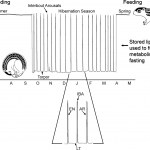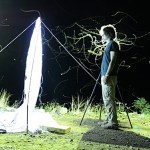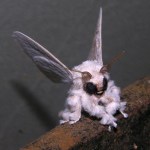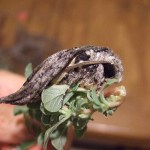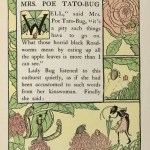moth
It is hard to believe that I have been sharing my passion for comparative physiology and its application to human and animal health with you for over 7 years now! In reminiscing over the last 7 years, I thought it would be fun to look back at the most popular posts. So, here goes...
The most popular blog post since 2010 featured the adorable Venezuelan poodle moth...
____
Posted August 29, 2012:
I was browsing through The Scientist and came across this image of a Venezuelan poodle moth that I could not resist sharing:
Image by: Arthur Anker on flickr. What is interesting about this…
Highlights from today's sessions included:
Norelia Ordonez-Castillo, undergraduate student from Fort Hays State University, presented her research on channel catfish. According to Norelia, these fish can become obese so her research was geared towards trying to find out how their receptor for LDL cholesterol differs from rodents and humans. But what I want to know is whether the obese catfish tastes better...
Image of channel catfish by Ryan Somma via Wikimedia Commons
Christine Schwartz, Investigator from University of Wisconsin-La Crosse, studied how the brain of hibernating…
Image from the American Physiological Society's website.http://www.the-aps.org/mm/Conferences/APS-Conferences/2014-Conferences/…
Wednesday was the last day of the meeting that culminated in a closing banquet with an awards session to honor students who had exceptional presentations. What an impressive group of young comparative physiologists! The plenary lecture was given by Dr. Steven Chown (Monash Univ, Australia). He spoke about climate change forecasts and continuing environmental changes and how important it is to understand how animals adapt to changing conditions in order to…
Eran Levin in front of a blacklight screen.
Eran Levin, a postdoctoral researcher at the University of Arizona studies Hawk Moths. He used a technique called backlighting to catch them and in the process catches numerous other insects as well.
Moths navigate by keeping bright objects like the moon and stars at a constant angle. It turns out that artificial light disrupts the moths's detection of moonlight. They end up using the artificial light source as a navigation cue and as a result wind up circling the light bulb to keep it at a constant angle.
Check out his blog entry in Scientific…
I was browsing through The Scientist and came across this image of a Venezuelan poodle moth that I could not resist sharing:
Image by: Arthur Anker on flickr
What is interesting about this particular moth is that scientists are currently trying to figure out exactly what type of moth it is (its phylogeny). Needless to say, the image of this fluffy moth has gone viral. The flickr website by Dr. Arthur Anker, a Zoologist, contains photos of numerous other beautiful butterflies and moths.
Other favorites:
Leucanella maasseni, which looks like it…
My silkworms are starting to turn into silkmoths! The first moth emerged from his cocoon this weekend, I hope more are close behind so that he can mate before he dies! I didn't expect him to come out so soon so I didn't have my real camera but I wanted to share my blurry phone pictures of the event:
In industrial silk production they can't use the cocoon that gets left behind because the moth uses an enzyme called cocoonase to chew his way out, breaking the otherwise continuous silk thread. I'm starting to explore ways that I can use this silk though--so far I've only made friendship…
Not Exactly Pocket Science is a set of shorter write-ups on new stories with links to more detailed takes by the world's best journalists and bloggers. It is meant to complement the usual fare of detailed pieces that are typical for this blog.
Geneticist sequences own genome, finds genetic cause of his disease
If you've got an inherited disease and you want to find the genetic faults responsible, it certainly helps if you're a prominent geneticist. James Lupski (right) from the Baylor College of Medicine suffers from an incurable condition called Charcot-Marie-Tooth (CMT) disease, which…
tags: animals, hummingbirds, insects, biology, streaming video
This is a lesson in observation. This is a North American animal. I know what this is (and I knew as soon as I saw the still image on the video) but I am asking you: what is this; hummingbird or insect? And for a bonus, can you tell me the species?
This is a Common Clearwing, also known as the Hummingbird Clearwing Moth, Hemaris thysbe.
We've all seen articles detailing remote controling insects via electric pulse systems on their nervous centers. A paper that we uncovered from last year (thanks NVDH), however, details the beginnings of a new kind of remote controlled moth. Hold on to your hats, because this is about to get complicated.
Basically, it all started when aeronautic engineers started looking closely at "insect inspired micro aircraft" as a complement to the large air vehicles that we currently employ. Large vehicles such as planes and helicopters are so massive that they are only minutely affected by changes in…
tags: Tvärminne, zoological field research station, Finland, nature
Hornet Moth, Sesia apiformis: Hymenopteran biomimic.
Tvärminnen eläintieteellinen asema
(Tvärminne Zoological field research station) in southwestern Finland.
[read more about it: English :: Suomeksi :: PÃ¥ Svenska]
Image: Bob O'Hara, 15 July 2009 [larger view]. (raw image)
This insect is sitting on my camera (to give you a sense of size). I would happily share all my gorgeous photographs with you (several of which were stunning), but my camera batteries died while I was photographing and didn't save roughly 100…
The Cheerful Cricket and Others (1907)
Children's Digital Library
The Children's Digital Library doesn't have a sleek interface and it can be a bit hiccupy, but if you poke around you'll find a surprising number of vintage children's books like The Cheerful Cricket and Others (1907) or The Illustrated Alphabet of Birds (1851).
Best of all, several of the Oz books illustrated by John R. Neill are here in their entirety! I remember checking these out of the library when I was sick as a child. I think my mom must have charmed the librarian because I remember taking literally stacks of books at…
Just in time for Halloween, researchers in Siberia have identified a new species of vampire moth. Scratch that, make that two species of vampire moth, both discovered by Jennifer Zaspel from the University of Florida in Gainesville.
The moths are remarkably similar to a strictly vegetarian moth called the Calyptra thalictri, leading Zaspel to speculate that this blood sucking relative represents a new evolutionary direction.
For the love of God, just stop...
Regular fruit eating moths often possess hooked/barbed tongues used to get under the skin of different fruits in order to get to the…
No one quite knows when the Light Brown Apple Moth arrived on the shores of California, but after DNA identification in 2007, it wasted no time pitting the California Department of Food and Agriculture and the populace of San Francisco against one another. Today the CDFA announced a new strategy for the eradication campaign: releasing bioengineered sterile moths to lure-in amorous males.
Ever tried to neuter a moth? Not easy...
Indigenous to Australia, the non-descript moth breeds prolifically with an average of three broods generations per year. However, much like Paul Hogan before it, the…
Time once again for some of Igor Siwanowicz's spectacular insect photography. We've brought you his mantis photos in the past (#1 , #2, and #3) so we decided to switch it up and take a look at some of his moths. Unfortunately Igor doesn't tell us which species we are looking at, but maybe some of our entomologically inclined readers will chime in.
more below the fold
This last one might be a butterfly, but that's a killer proboscis...
tags: moth, Ecpantheria scribonia, giant leopard moth, Image of the Day
During the process of splitting and transferring wood from the woodpile yesterday, we discovered a large (2.5" long) hairy caterpillar. I have enclosed two pictures of it [the second is below the fold]; it is the larval stage of the Giant Leopard Moth, Ecpantheria scribonia. The life cycle is described and the adult is pictured here.
Image: Dave Rintoul [wallpaper size]
Image: Dave Rintoul, KSU [wallpaper size]
tags: moth, Melanchroia chepise, white-tipped black geometrid, Image of the Day
This diurnal Melanchroia chepise posed prettily this morning (10/21/07) on the wall of my apartment breezeway in the Heights section of Houston, Texas.
Image: Biosparite [larger view]
tags: moth, lined sphinx, Hyles lineata, Image of the Day
Hyles lineata, the lined sphinx.
(Image captured in Bozeman, Montana).
Image: Martin Richard, author of Science for Kids.
tags: Carolina Sphinx Moth, Tobacco Hornworm Moth, Manducca sexta, Image of the Day
Manducca sexta, or the Carolina Sphinx Moth.
The larva, is known as the tobacco hornworm, or tomato worm. It has seven diagonal white lines on each side, and a red "horn" at the end of the abdomen. It feeds on plants in the nightshade family, and is known for its voracious appetite which can decimate a small tomato garden in no time! This one was first spotted on the window screen on the 2nd floor porch of my house. After I photographed it,
it was released unharmed. Although I have seen many tomato…
